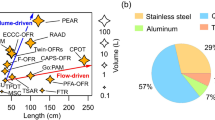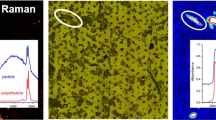Abstract
Many aromatic compounds (e.g., polycyclic aromatic hydrocarbons (PAHs)) found in atmospheric aerosols are toxic and exist in both unsubstituted and substituted forms. Previous studies have mainly concentrated on investigating unsubstituted PAHs, leaving the substituted compounds largely uncharacterized. This study focuses on detection of both unsubstituted and substituted aromatics in ambient aerosol samples using ultrahigh-resolution mass spectrometry. Aerosol samples collected from roadside, urban, and suburban sites in Hong Kong were characterized by Fourier-transform ion cyclotron resonance mass spectrometry (FT-ICR-MS) coupled with atmospheric pressure photoionization (APPI) or electrospray ionization (ESI). In the APPI+ mode, 166 aromatic CH formulas (i.e., formulas containing C and H only and with a double bond equivalent (DBE) of 4 or higher) were determined through molecular formula calculations based on an accurate m/z determination. Among the determined aromatic CH formulas, 141 are possible alkylated monocyclic aromatic hydrocarbon (MAH) or PAH formulas, and account for ≥ 45% of the total intensity by aromatic CH+ formulas. Both APPI+ and ESI+ are effective in detecting nitroaromatics (i.e., CHO2N1 formulas and DBE ≥ 5). The two ionization modes provide complementary formula coverage, with formulas determined by APPI+ extending to higher DBE and those by ESI+ covering higher carbon numbers. Alkylated nitrobenzene compounds are the most abundant among nitroaromatics, and they, together with alkylated nitro-PAHs, account for > 80% of the total intensity of aromatic CHO2N+ formulas, indicating the importance of these compounds in real aerosol samples. Aromatic CHN+ and CHO+ formulas are also determined, confirming the atmospheric presence of some previously reported O- and N-containing aromatic compounds and revealing new possible formulas. The determination of aromatic organic formulas in this study provides useful guidance for future quantitative analysis of hazardous aromatic compounds. Future work is needed to determine the abundance and to study the toxicity of alkylated MAHs and PAHs outside the 16 US EPA priority PAH compounds.

Graphical abstract





Similar content being viewed by others
References
Durant JL, Busby WF, Lafleur AL, Penman BW, Crespi CL. Human cell mutagenicity of oxygenated, nitrated and unsubstituted polycyclic aromatic hydrocarbons associated with urban aerosols. Mutat Res Genet Toxicol. 1996;371:123–57.
IARC. IARC monographs on the evaluation of carcinogenic risks to humans. 2010. http://monographs.iarc.fr/ENG/Monographs/vol92/mono92.pdf. Accessed 17 Feb 2017.
Duan HW, He ZN, Ma JX, Zhang B, Sheng ZG, Bin P, et al. Global and MGMT promoter hypomethylation independently associated with genomic instability of lymphocytes in subjects exposed to high-dose polycyclic aromatic hydrocarbon. Arch Toxicol. 2013;87:2013–22.
Li DC, Liu CX, Yu HH, Zeng XW, Xing XM, Chen LP, et al. AhR is negatively regulated by miR-203 in response to TCDD or BaP treatment. Toxicol Res. 2014;3:142–51.
U.S. EPA. Development of a relative potency factor (Rpf) approach for polycyclic aromatic hydrocarbon (PAH) mixtures (external review draft). U.S. Environmental Protection Agency, Washington, DC, EPA/635/R-08/012A, 2010. (It does not represent the US EPA determination or policy.) https://yosemite.epa.gov/sab/sabproduct.nsf/36a1ca3f683ae57a85256ce9006a32d0/E65D909C98520C1D85257501005E46AE/$File/IRIS_PAH_RPF_ERD_Feb+2010.pdf. Accessed 17 Feb 2017.
Vijayalakshmi KP, Suresh CH. Theoretical studies on the carcinogenic activity of diol epoxide derivatives of PAH: proton affinity and aromaticity as decisive descriptors. Org Biomol Chem. 2008;6:4384–90.
Desler C, Johannessen C, Rasmussen LJ. Repair of DNA damage induced by anthanthrene, a polycyclic aromatic hydrocarbon (PAH) without bay or fjord regions. Chem Biol Interact. 2009;177:212–7.
Phillips DH, Grover PL, Sims P. Quantitative-determination of the covalent binding of a series of polycylic hydrocarbons to DNA in mouse skin. Int J Cancer. 1979;23:201–8.
Andersson JT, Achten C. Time to say goodbye to the 16 EPA PAHs? Toward an up-to-date use of PACs for environmental purposes. Polycycl Aromat Compd. 2015;35:330–54.
Pedersen DU, Durant JL, Taghizadeh K, Hemond HF, Lafleur AL, Cass GR. Human cell mutagens in respirable airborne particles from the Northeastern United States. 2. Quantification of mutagens and other organic compounds. Environ Sci Technol. 2005;39:9547–60.
Jiang B, Liang YM, Xu CM, Zhang JY, Hu M, Shi Q. Polycyclic aromatic hydrocarbons (PAHs) in ambient aerosols from Beijing: characterization of low volatile PAHs by positive-ion atmospheric pressure photoionization (APPI) coupled with Fourier transform ion cyclotron resonance. Environ Sci Technol. 2014;48:4716–23.
Pace CM, Betowski LD. Measurement of high-molecular-weight polycyclic aromatic-hydrocarbons in soils by particle-beam high-performance liquid-chromatography mass. J Am Soc Mass Spectrom. 1995;6:597–607.
Marvin CH, Smith RW, Bryant DW, McCarry BE. Analysis of high-molecular-mass polycyclic aromatic hydrocarbons in environmental samples using liquid chromatography-atmospheric pressure chemical ionization mass spectrometry. J Chromatogr A. 1999;863:13–24.
Caslavsky J, Kotlarikova P. High-molecular-weight polycyclic aromatic hydrocarbons in the area and vicinity of the DEZA Chemical Plant, Czech Republic. Polycycl Aromat Compd. 2003;23:327–52.
Lung SCC, Liu CH. Fast analysis of 29 polycyclic aromatic hydrocarbons (PAHs) and nitro-PAHs with ultra-high performance liquid chromatography-atmospheric pressure photoionization-tandem mass spectrometry. Sci Rep. 2015;5.
Raffaelli A, Saba A. Atmospheric pressure photoionization mass spectrometry. Mass Spectrom Rev. 2003;22:318–31.
Dou J, Lin P, Kuang BY, Yu JZ. Reactive oxygen species production mediated by humic-like substances in atmospheric aerosols: enhancement effects by pyridine, imidazole, and their derivatives. Environ Sci Technol. 2015;49:6457–65.
Lin P, Rincon AG, Kalberer M, Yu JZ. Elemental composition of HULIS in the Pearl River Delta region, China: results inferred from positive and negative electrospray high resolution mass spectrometric data. Environ Sci Technol. 2012;46:7454–62.
Lin P, Yu JZ, Engling G, Kalberer M. Organosulfates in humic-like substance fraction isolated from aerosols at seven locations in East Asia: a study by ultra-high-resolution mass spectrometry. Environ Sci Technol. 2012;46:13118–27.
McMurry J. Organic chemistry. 8th ed. 2012. pp. 546.
Ho SSH, Yu JZ. In-injection port thermal desorption and subsequent gas chromatography–mass spectrometric analysis of polycyclic aromatic hydrocarbons and n-alkanes in atmospheric aerosol samples. J Chromatogr A. 2004;1059:121–9.
Frysinger GS, Gaines RB, Reddy CM. GC x GC—a new analytical tool for environmental forensics. Environ Forensic. 2002;3:27–34.
Purcaro G, Tranchida PQ, Jacques RA, Caramao EB, Moret S, Conte L, et al. Characterization of the yerba mate (Ilex paraguariensis) volatile fraction using solid-phase microextraction-comprehensive 2-D GC-MS. J Sep Sci. 2009;32:3755–63.
Li SF, Cao J, Hu SZ, Luo GM. Characterization of compounds in unresolved complex mixtures (UCM) of a Mesoproterzoic shale by using GC x GC-TOFMS. Mar Pet Geol. 2015;66:791–800.
Lintelmann J, Fischer K, Karg E, Schroppel A. Determination of selected polycyclic aromatic hydrocarbons and oxygenated polycyclic aromatic hydrocarbons in aerosol samples by high-performance liquid chromatography and liquid chromatography-tandem mass spectrometry. Anal Bioanal Chem. 2005;381:508–19.
Okuda T, Naoi D, Tenmoku M, Tanaka S, He KB, Ma YL, et al. Polycyclic aromatic hydrocarbons (PAHs) in the aerosol in Beijing, China, measured by aminopropylsilane chemically-bonded stationary-phase column chromatography and HPLC/fluorescence detection. Chemosphere. 2006;65:427–35.
Ghislain T, Faure P, Michels R. Detection and monitoring of PAH and oxy-PAHs by high resolution mass spectrometry: comparison of ESI, APCI and APPI source detection. J Am Soc Mass Spectrom. 2012;23:530–6.
Zeigler C, MacNamara K, Wang ZD, Robbat A. Total alkylated polycyclic aromatic hydrocarbon characterization and quantitative comparison of selected ion monitoring versus full scan gas chromatography/mass spectrometry based on spectral deconvolution. J Chromatogr A. 2008;1205:109–16.
Casal CS, Arbilla G, Correa SM. Alkyl polycyclic aromatic hydrocarbons emissions in diesel/biodiesel exhaust. Atmos Environ. 2014;96:107–16.
Tancell PJ, Rhead MM, Pemberton RD, Braven J. Diesel combustion of an alkylated polycyclic aromatic hydrocarbon. Fuel. 1996;75:717–23.
Schnelle-Kreis J, Sklorz M, Orasche J, Stolzel M, Peters A, Zimmermann R. Semi volatile organic compounds in ambient PM(2.5). Seasonal trends and daily resolved source contributions. Environ Sci Technol. 2007;41:3821–8.
Karavalakis G, Short D, Vu D, Russell R, Hajbabaei M, Asa-Awuku A, et al. Evaluating the effects of aromatics content in gasoline on gaseous and particulate matter emissions from SI-PFI and SIDI vehicles. Environ Sci Technol. 2015;49:7021–31.
Lian JJ, Ren Y, Chen JM, Wang T, Cheng TT. Distribution and source of alkyl polycyclic aromatic hydrocarbons in dustfall in Shanghai, China: the effect on the coastal area. J Environ Monit. 2009;11:187–92.
Alves CA, Vicente AMP, Gomes J, Nunes T, Duarte M, Bandowe BAM. Polycyclic aromatic hydrocarbons (PAHs) and their derivatives (oxygenated-PAHs, nitrated-PAHs and azaarenes) in size-fractionated particles emitted in an urban road tunnel. Atmos Res. 2016;180:128–37.
Ho SSH, Yu JZ, Chow JC, Zielinska B, Watson JG, Sit EHL, et al. Evaluation of an in-injection port thermal desorption-gas chromatography/mass spectrometry method for analysis of non-polar organic compounds in ambient aerosol samples. J Chromatogr A. 2008;1200:217–27.
Jiang B, Kuang BY, Liang YM, Zhang JY, Huang XHH, Xu CM, et al. Molecular composition of urban organic aerosols on clear and hazy days in Beijing: a comparative study using FT-ICR MS. Environ Chem. 2016;13:888–901.
Xie FW, Shang JJ, Guo JZ, Ge Z, Mang SS. Determination of seven nitrobenzene compounds in mainstream cigarette smoke with heart-cutting two-dimensional gas chromatography. J Chromatogr Sci. 2012;50:387–92.
Bandowe BAM, Meusel H, Huang RJ, Ho KF, Cao JJ, Hoffmann T, et al. PM2.5-bound oxygenated PAHs, nitro-PAHs and parent-PAHs from the atmosphere of a Chinese megacity: seasonal variation, sources and cancer risk assessment. Sci Total Environ. 2014;473:77–87.
Alves CA, Vicente AM, Custodio D, Cerqueira M, Nunes T, Pio C, et al. Polycyclic aromatic hydrocarbons and their derivatives (nitro-PAHs, oxygenated PAHs, and azaarenes) in PM2.5 from Southern European cities. Sci Total Environ. 2017;595:494–504.
Bataineh M, Arabi AA, Iqbal J, Howari FM, Brack W. Method development for selective and nontargeted identification of nitro compounds in diesel particulate matter. Energy Fuel. 2017;31:11615–26.
Bandowe BAM, Meusel H, Huang RJ, Hoffmann T, Cao JJ, Ho KF. Azaarenes in fine particulate matter from the atmosphere of a Chinese megacity. Environ Sci Pollut Res. 2016;23:16025–36.
Neuwoehner J, Reineke AK, Hollender J, Eisentraeger A. Ecotoxicity of quinoline and hydroxylated derivatives and their occurrence in groundwater of a tar-contaminated field site. Ecotoxicol Environ Saf. 2009;72:819–27.
Ozel MZ, Hamilton JF, Lewis AC. New sensitive and quantitative analysis method for organic nitrogen compounds in urban aerosol samples. Environ Sci Technol. 2011;45:1497–505.
Murphy DM, Cziczo DJ, Froyd KD, Hudson PK, Matthew BM, Middlebrook AM, Peltier RE, Sullivan A, Thomson DS, Weber RJ. Single-particle mass spectrometry of tropospheric aerosol particles. J Geophys Res-Atmos. 2006; 111.
Yang XF, Lorjaroenphon Y, Cadwallader KR, Wang XL, Zhang YH, Lee JM. Analysis of particle-borne odorants emitted from concentrated animal feeding operations. Sci Total Environ. 2014;490:322–33.
Motohashi N, Meyer R, Molnar J, Parkanyi C, Fang XC. Chromatographic determination of benz[C]acridines and related-compounds in airborne carcinogens. J Chromatogr A. 1995;710:117–28.
Delhomme O, Millet M. Comparison of two analytical methods for the determination of azaarenes in atmospheric particulate matter. Polycycl Aromat Compd. 2008;28:518–32.
Lintelmann J, Franca MH, Hubner E, Matuschek G. A liquid chromatography-atmospheric pressure photoionization tandem mass spectrometric method for the determination of azaarenes in atmospheric particulate matter. J Chromatogr A. 2010;1217:1636–46.
Sauvain JJ, Due TV, Huynh CK. Development of an analytical method for the simultaneous determination of 15 carcinogenic polycyclic aromatic hydrocarbons and polycyclic aromatic nitrogen heterocyclic compounds. Application to diesel particulates. Fresenius J Anal Chem. 2001;371:966–74.
Falkovich AH, Rudich Y. Analysis of semivolatile organic compounds in atmospheric aerosols by direct sample introduction thermal desorption GC/MS. Environ Sci Technol. 2001;35:2326–33.
Ma YL, Hays MD. Thermal extraction-two-dimensional gas chromatography-mass spectrometry with heart-cutting for nitrogen heterocyclics in biomass burning aerosols. J Chromatogr A. 2008;1200:228–34.
Teich M, van Pinxteren D, Kecorius S, Wang ZB, Herrmann H. First quantification of imidazoles in ambient aerosol particles: potential photosensitizers, brown carbon constituents, and hazardous components. Environ Sci Technol. 2016;50:1166–73.
Stangl CM, Johnston MV. Aqueous reaction of dicarbonyls with ammonia as a potential source of organic nitrogen in airborne nanoparticles. J Phys Chem A. 2017;121:3720–7.
Samy S, Hays MD. Quantitative LC-MS for water-soluble heterocyclic amines in fine aerosols (PM2.5) at Duke Forest, USA. Atmos Environ. 2013;72:77–80.
Acknowledgements
We gratefully thank Bruker company for providing FT-ICR analysis.
Funding
This work was partially supported by the Natural Science Foundation of China (91543130).
Author information
Authors and Affiliations
Corresponding author
Ethics declarations
The authors declare that they have no conflicts of interest.
Rights and permissions
About this article
Cite this article
Kuang, BY., Yeung, H.S., Lee, C.C. et al. Aromatic formulas in ambient PM2.5 samples from Hong Kong determined using FT-ICR ultrahigh-resolution mass spectrometry. Anal Bioanal Chem 410, 6289–6304 (2018). https://doi.org/10.1007/s00216-018-1239-8
Received:
Revised:
Accepted:
Published:
Issue Date:
DOI: https://doi.org/10.1007/s00216-018-1239-8




